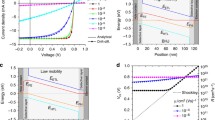Abstract
We numerically investigated space-charge effects in organic solar cells generating photocurrent with a low charge dissociation probability, using a drift-diffusion model with the Onsager-Braun model. In contrast to the knowledge that spacecharge effects decrease the photocurrent efficiency, we found that under certain circumstances, the efficiency can be enhanced by the space-charge effects. It is attributed to the increase of the charge dissociation probability spatially averaged in the active layer. Space-charge effects become more significant when mobilities are unbalanced leading to more enhancement in photocurrent efficiency.
Similar content being viewed by others
References
N. Tessler and N. Rappaport, J. Appl. Phys. 96, 1083 (2004).
I. Hwang and N. C. Greenham, Nanotechnology 5, 424012 (2008).
V. D. Mihailetchi, J. Wildeman, and P. W. M. Blom, Phys. Rev. Lett. 94, 126602 (2005).
D. Di Nuzzo, S. van Reenen, R. A. J. Janssen, M. Kemerink, and S. C. J. Meskers, Phys. Rev. B 87, 085207 (2013).
O. J. Sandberg, M. Nyman, and R. Österbacka, Phys. Rev. Appl. 1, 024003 (2014).
N. Rappaport, O. Solomesch, and N. Tessler, J. Appl. Phys. 98, 033714 (2005).
G. Juška, K. Arlauskas, J. Stuchlik, and R. Österbacka, J. Non-Cryst. Solids 352, 1167 (2006).
A. Pivrikas, H. Neugebauer, and N. S. Sariciftci, IEEE J. Sel. Topics Quantum Electron. 16, 1746 (2010).
M. Stolterfoht, B. Philippa, A. Armin, A. K. Pandey, R. D. White, P. L. Burn, P. Meredith, and A. Pivrikas, Appl. Phys. Lett. 105, 013302 (2014).
I. Hwang, C. R. McNeill, and N. C. Greenham, J. Appl. Phys. 106, 094506 (2009).
C. L. Braun, J. Chem. Phys. 80, 4175 (1983).
J. C. Scott and G. G. Malliaras, Chem. Phys. Lett. 299, 115 (1999).
J. A. Barker, C. M. Ramsdale, and N. C. Greenham, Phys. Rev. B 67, 075205 (2003).
S. Ochiai, P. Kumar, K. Santhakumar, and P.-K. Shin, Electron. Mater. Lett. 9, 399 (2013).
I. Oh, G. Kim, S. Han, and S. Oh, Electron. Mater. Lett. 9, 375 (2013).
Author information
Authors and Affiliations
Corresponding author
Rights and permissions
About this article
Cite this article
Yoon, S., Hwang, I. Photocurrent efficiency enhancement by space-charge effects in organic solar cells with low charge dissociation probability. Electron. Mater. Lett. 11, 41–45 (2015). https://doi.org/10.1007/s13391-014-4248-6
Received:
Accepted:
Published:
Issue Date:
DOI: https://doi.org/10.1007/s13391-014-4248-6




